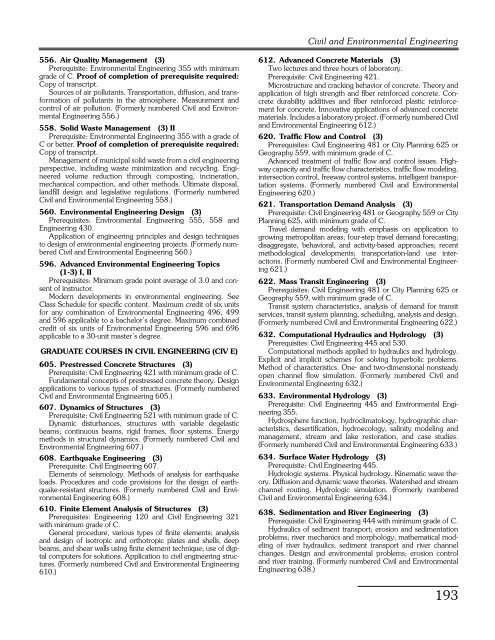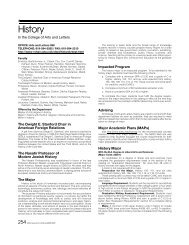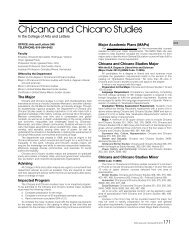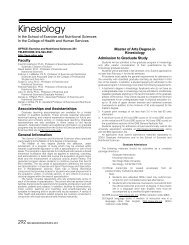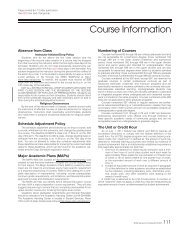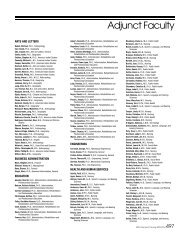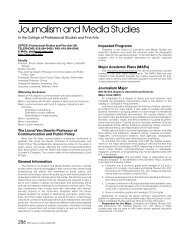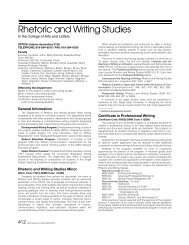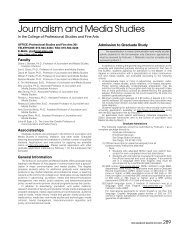President Stephen L. Weber - San Diego State University ...
President Stephen L. Weber - San Diego State University ...
President Stephen L. Weber - San Diego State University ...
You also want an ePaper? Increase the reach of your titles
YUMPU automatically turns print PDFs into web optimized ePapers that Google loves.
556. Air Quality Management (3)<br />
Prerequisite: Environmental Engineering 355 with minimum<br />
grade of C. Proof of completion of prerequisite required:<br />
Copy of transcript.<br />
Sources of air pollutants. Transportation, diffusion, and transformation<br />
of pollutants in the atmosphere. Measurement and<br />
control of air pollution. (Formerly numbered Civil and Environmental<br />
Engineering 556.)<br />
558. Solid Waste Management (3) II<br />
Prerequisite: Environmental Engineering 355 with a grade of<br />
C or better. Proof of completion of prerequisite required:<br />
Copy of transcript.<br />
Management of municipal solid waste from a civil engineering<br />
perspective, including waste minimization and recycling. Engineered<br />
volume reduction through composting, incineration,<br />
mechanical compaction, and other methods. Ultimate disposal,<br />
landfill design and legislative regulations. (Formerly numbered<br />
Civil and Environmental Engineering 558.)<br />
560. Environmental Engineering Design (3)<br />
Prerequisites: Environmental Engineering 555, 558 and<br />
Engineering 430.<br />
Application of engineering principles and design techniques<br />
to design of environmental engineering projects. (Formerly numbered<br />
Civil and Environmental Engineering 560.)<br />
596. Advanced Environmental Engineering Topics<br />
(1-3) I, II<br />
Prerequisites: Minimum grade point average of 3.0 and consent<br />
of instructor.<br />
Modern developments in environmental engineering. See<br />
Class Schedule for specific content. Maximum credit of six units<br />
for any combination of Environmental Engineering 496, 499<br />
and 596 applicable to a bachelor’s degree. Maximum combined<br />
credit of six units of Environmental Engineering 596 and 696<br />
applicable to a 30-unit master’s degree.<br />
GRADUATE COURSES IN CIVIL ENGINEERING (CIV E)<br />
605. Prestressed Concrete Structures (3)<br />
Prerequisite: Civil Engineering 421 with minimum grade of C.<br />
Fundamental concepts of prestressed concrete theory. Design<br />
applications to various types of structures. (Formerly numbered<br />
Civil and Environmental Engineering 605.)<br />
607. Dynamics of Structures (3)<br />
Prerequisite: Civil Engineering 521 with minimum grade of C.<br />
Dynamic disturbances, structures with variable degelastic<br />
beams; continuous beams, rigid frames, floor systems. Energy<br />
methods in structural dynamics. (Formerly numbered Civil and<br />
Environmental Engineering 607.)<br />
608. Earthquake Engineering (3)<br />
Prerequisite: Civil Engineering 607.<br />
Elements of seismology. Methods of analysis for earthquake<br />
loads. Procedures and code provisions for the design of earthquake-resistant<br />
structures. (Formerly numbered Civil and Environmental<br />
Engineering 608.)<br />
610. Finite Element Analysis of Structures (3)<br />
Prerequisites: Engineering 120 and Civil Engineering 321<br />
with minimum grade of C.<br />
General procedure, various types of finite elements; analysis<br />
and design of isotropic and orthotropic plates and shells, deep<br />
beams, and shear walls using finite element technique; use of digital<br />
computers for solutions. Application to civil engineering structures.<br />
(Formerly numbered Civil and Environmental Engineering<br />
610.)<br />
Civil and Environmental Engineering<br />
612. Advanced Concrete Materials (3)<br />
Two lectures and three hours of laboratory.<br />
Prerequisite: Civil Engineering 421.<br />
Microstructure and cracking behavior of concrete. Theory and<br />
application of high strength and fiber reinforced concrete. Concrete<br />
durability additives and fiber reinforced plastic reinforcement<br />
for concrete. Innovative applications of advanced concrete<br />
materials. Includes a laboratory project. (Formerly numbered Civil<br />
and Environmental Engineering 612.)<br />
620. Traffic Flow and Control (3)<br />
Prerequisites: Civil Engineering 481 or City Planning 625 or<br />
Geography 559, with minimum grade of C.<br />
Advanced treatment of traffic flow and control issues. Highway<br />
capacity and traffic flow characteristics, traffic flow modeling,<br />
intersection control, freeway control systems, intelligent transportation<br />
systems. (Formerly numbered Civil and Environmental<br />
Engineering 620.)<br />
621. Transportation Demand Analysis (3)<br />
Prerequisite: Civil Engineering 481 or Geography 559 or City<br />
Planning 625, with minimum grade of C.<br />
Travel demand modeling with emphasis on application to<br />
growing metropolitan areas; four-step travel demand forecasting;<br />
disaggregate, behavioral, and activity-based approaches; recent<br />
methodological developments; transportation-land use interactions.<br />
(Formerly numbered Civil and Environmental Engineering<br />
621.)<br />
622. Mass Transit Engineering (3)<br />
Prerequisites: Civil Engineering 481 or City Planning 625 or<br />
Geography 559, with minimum grade of C.<br />
Transit system characteristics, analysis of demand for transit<br />
services, transit system planning, scheduling, analysis and design.<br />
(Formerly numbered Civil and Environmental Engineering 622.)<br />
632. Computational Hydraulics and Hydrology (3)<br />
Prerequisites: Civil Engineering 445 and 530.<br />
Computational methods applied to hydraulics and hydrology.<br />
Explicit and implicit schemes for solving hyperbolic problems.<br />
Method of characteristics. One- and two-dimensional nonsteady<br />
open channel flow simulation. (Formerly numbered Civil and<br />
Environmental Engineering 632.)<br />
633. Environmental Hydrology (3)<br />
Prerequisite: Civil Engineering 445 and Environmental Engineering<br />
355.<br />
Hydrosphere function, hydroclimatology, hydrographic characteristics,<br />
desertification, hydroecology, salinity modeling and<br />
management, stream and lake restoration, and case studies.<br />
(Formerly numbered Civil and Environmental Engineering 633.)<br />
634. Surface Water Hydrology (3)<br />
Prerequisite: Civil Engineering 445.<br />
Hydrologic systems. Physical hydrology. Kinematic wave theory.<br />
Diffusion and dynamic wave theories. Watershed and stream<br />
channel routing. Hydrologic simulation. (Formerly numbered<br />
Civil and Environmental Engineering 634.)<br />
638. Sedimentation and River Engineering (3)<br />
Prerequisite: Civil Engineering 444 with minimum grade of C.<br />
Hydraulics of sediment transport; erosion and sedimentation<br />
problems; river mechanics and morphology; mathematical modeling<br />
of river hydraulics; sediment transport and river channel<br />
changes. Design and environmental problems; erosion control<br />
and river training. (Formerly numbered Civil and Environmental<br />
Engineering 638.)<br />
193


